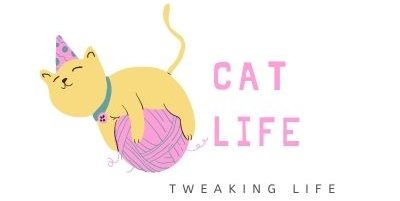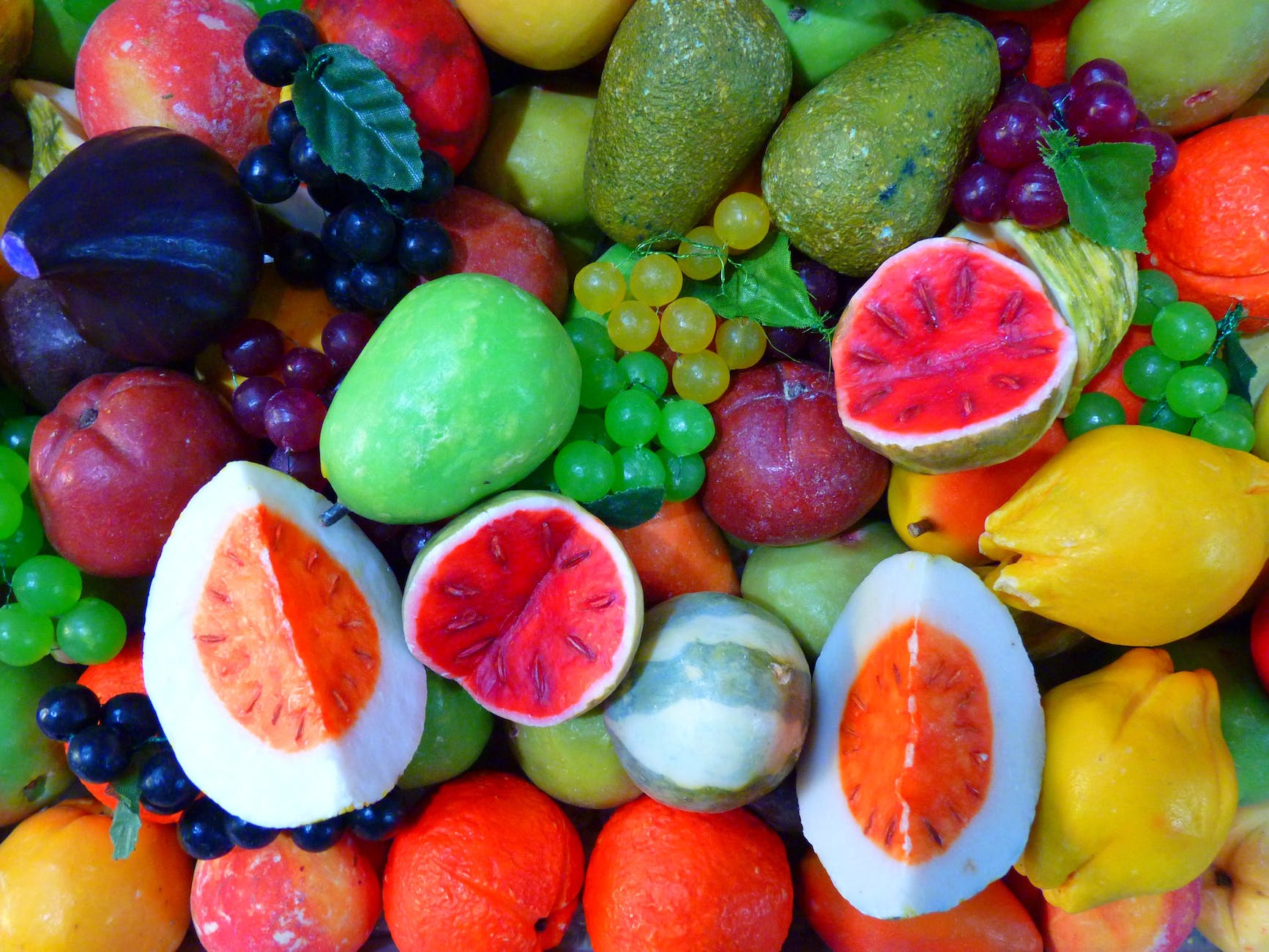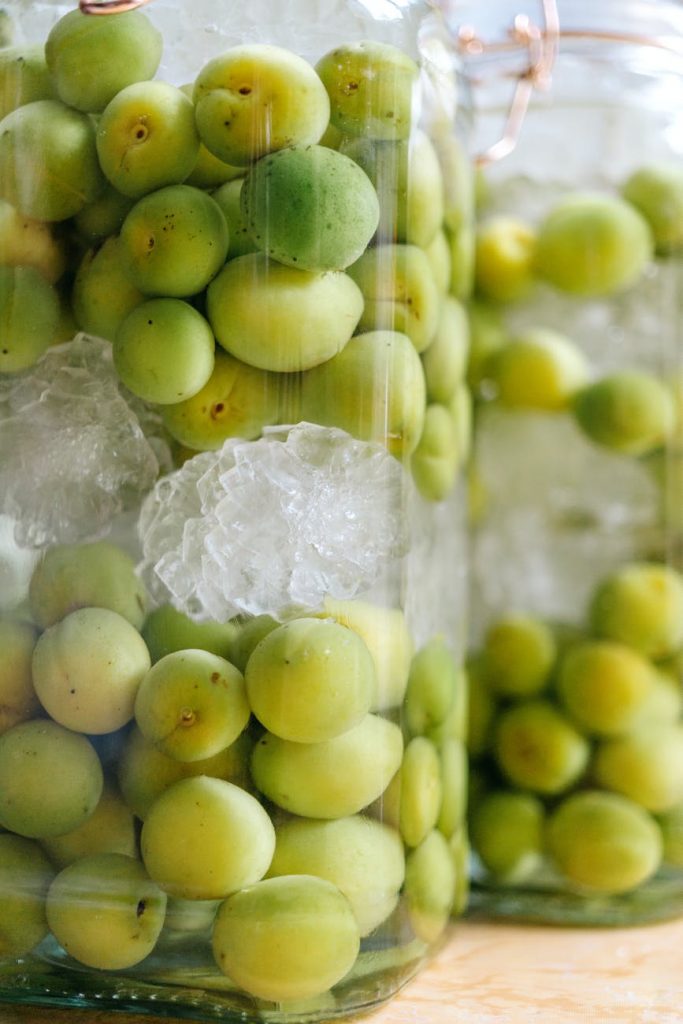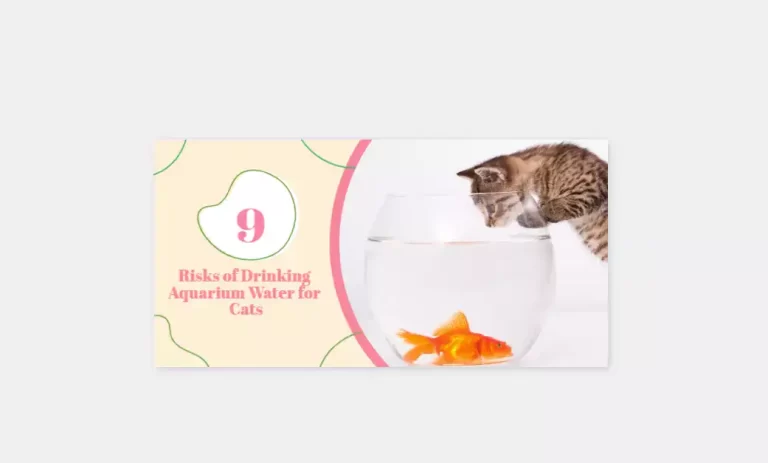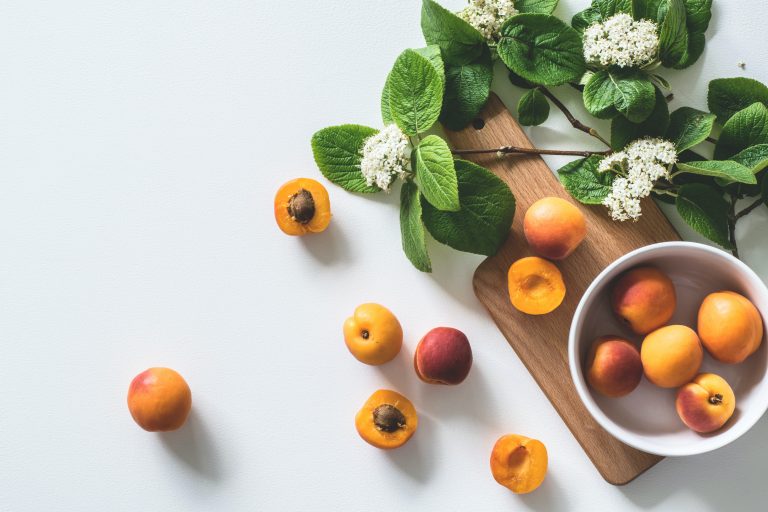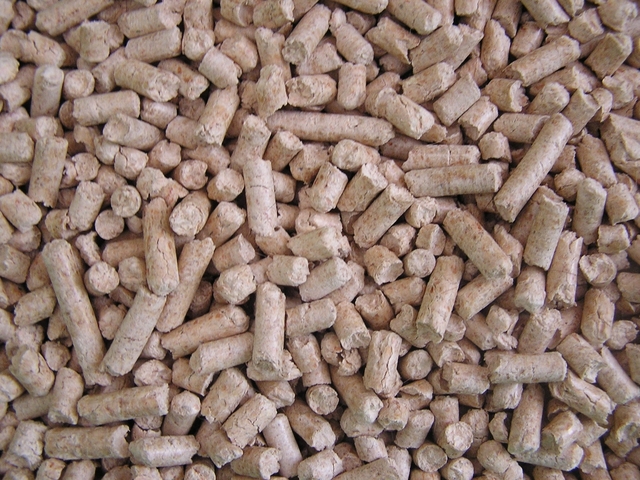Which Fruits Can Cats Eat? 25 Fruits For Your Feline
With the weather getting warmer, many people are considering what types of fruits to offer their kitties. What type of fruit can cats eat?
When it comes to which fruits your cat should be eating, you’ll find that there is no easy answer. Yes, some foods may be more healthy for your feline friend than others.
But, every single choice has its pros and cons, as well as potential health risks in general, and these risks, vary depending on individual animals and their unique medical needs.
In today’s blog post, I’ll share with you everything that I’ve learned about what types of fruits are best for my feline friends. So read on to learn more to get all your questions answered!
Table of Contents
Which fruits can cats eat?
1. Bananas
Cats can eat bananas, and they may even enjoy the taste and texture. They are a good source of several vitamins and minerals, including potassium and vitamin C. Additionally, the dietary fiber in bananas can help keep your cat’s digestive system functioning properly.
Cautions:
Because of their high sugar content, it is important to feed bananas to cats only occasionally and in small amounts. Too much sugar can lead to weight gain or other health problems for cats
2. Watermelons
Cats can eat watermelon, but only in small amounts. Watermelon is not a part of a cat’s natural diet, so it’s important to introduce it slowly and in moderation.
Additionally, they are a great source of hydration, vitamins, and minerals. The watery fruit is also low in calories and fat.
How to feed watermelon to cats:
The best way to feed watermelon to cats is to cut it into small pieces and remove the seeds. You can offer it as a treat or mix it into their regular food.
3. Cherries

Cherries are good for cats as they’re packed with vitamins A, C, and E, as well as potassium and fiber. One cup of cherries has about 87 calories and 3 grams of fiber.
They also have many health benefits including the ability to improve brain function, lower cholesterol levels, and prevent cancer.
Cherry dangers:
Although cherries are generally safe for cats to eat, there are a few potential dangers to be aware of. The pits of cherries contain cyanide which can be poisonous to cats if ingested.
Cherry trees also produce a chemical called benzaldehyde which can be toxic to cats if they eat too many cherries.
4. Mangos
Mangoes are safe for cats to eat. In fact, they can be a healthy treat for your feline friend. The juicy fruits are an excellent source of vitamins A and C. They also contain fiber, potassium, and magnesium. Mangoes are low in calories and fat.
How to feed a cat mango:
Cut the mango into small pieces or slices so that your cat can easily eat it. You can also mash the mango to make it easier for your cat to consume.
If you’re feeding your cat fresh mango, make sure to remove the pit before giving it to them.
5. Peaches
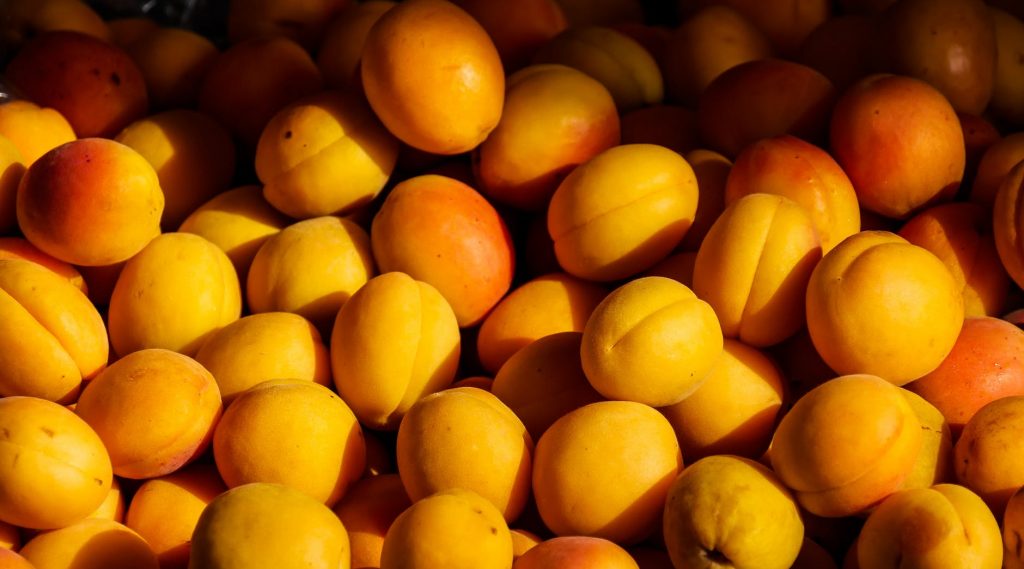
Cats love peaches and they are a great source of nutrition for them. They are a good source of essential fatty acids which are necessary for maintaining healthy skin and coat.
Additionally, the high fiber content in peaches can help improve your cat’s digestive health by promoting regularity and preventing constipation.
If your cat struggles with hairballs, then peaches might just be the answer for you. The fiber in peaches can help reduce hairballs by helping the hair pass through the digestive system more easily. They are also low in calories and fat.
The fruit is a good source of water that can help keep your cat hydrated, especially during the hot summer months.
6. Strawberries
In moderation, cats eat strawberries. The berry is a good source of vitamins C and K, as well as fiber. A single fruit contains about 3 calories and 0 grams of fat.
Because they’re packed with nutrients, there are some potential benefits to feeding your cat strawberries in moderation. For example, the vitamin C in strawberries may help to boost your cat’s immune system.
Additionally, the fiber in strawberries could help with digestive issues.
Possible risks of feeding strawberries to your cat
The biggest risk of feeding strawberries to your cat is that they may be allergic to them. Symptoms of a strawberry allergy in cats can include itching, swelling, and difficulty breathing.
If you notice any of these symptoms after your cat eats strawberries, it’s important to take them to the vet right away.
Additionally, because strawberries are relatively high in sugar, feeding them to your cat in large quantities could lead to weight gain or other health problems associated with too much sugar intake. So it’s important to feed them only in moderation.
7. Avocado
Cats can eat avocado, but it is not a necessary part of their diet. They are a good source of vitamins A, C, and E and also contain potassium and fiber.
Avocado flesh is safe for cats to eat, but the pit and skin are not. If your cat does eat avocado, make sure they do not eat the pit or skin as these can be harmful.
How to feed avocado to cats:
If you want to feed your cat avocado, give them a small piece of the flesh without the pit or skin. You can also mash up the avocado flesh and mix it with their food.
8. Apples
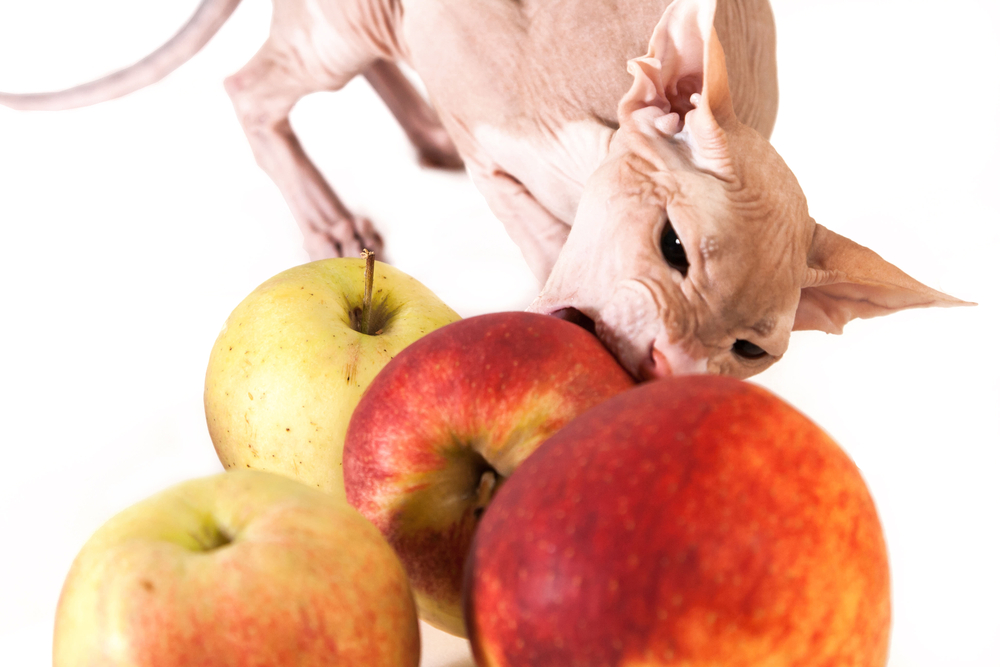
Yes, cats can eat apples. Apples are a good source of fiber and vitamins A, C, and K. They also contain a small amount of sugar.
All of these nutrients are beneficial for cats. However, the sugar content is something to be aware of if your cat is diabetic or overweight.
Precautions:
The skin and seeds of apples contain a compound called cyanogenic glycosides. When these compounds are ingested, they release cyanide gas. Cyanide is poisonous to all animals, including cats.
So, it’s important to remove the skin and seeds from apples before feeding them to your cat.
9. Raspberries
Cats can eat raspberries safely as long as it’s in moderation. Raspberries are a good source of fiber, vitamins and antioxidants. They can also help to freshen a cat’s breath.
Possible risks of feeding raspberries to your cat
Cats are at risk of choking on raspberries or any other small fruit. They may also suffer from gastrointestinal issues if they eat too many raspberries.
10. Can Cats Eat blackberries
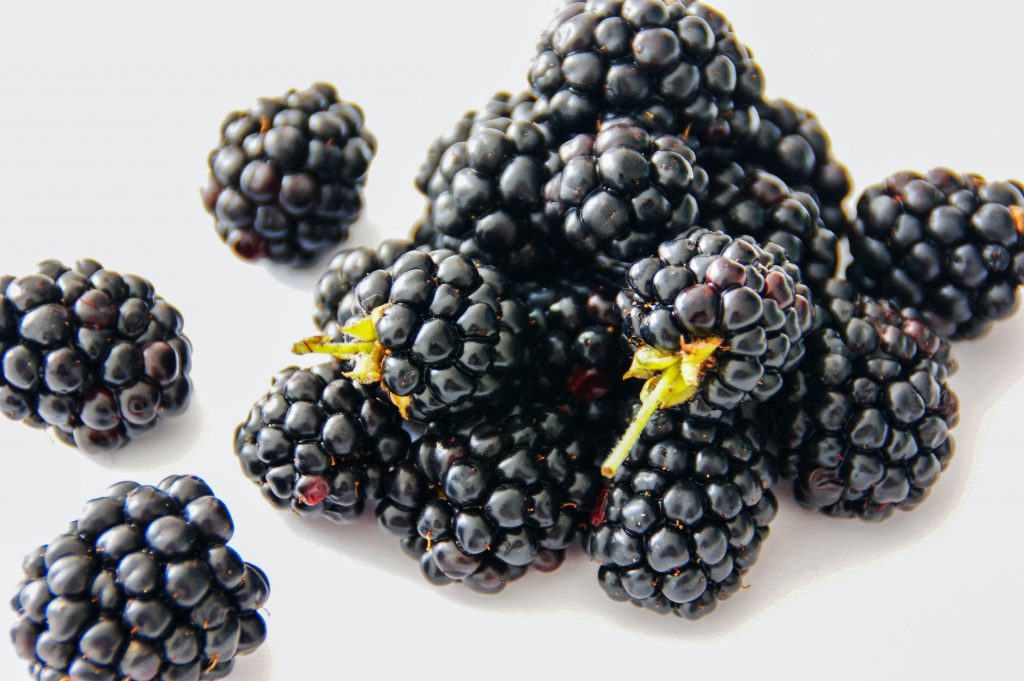
Yes, cats can safely eat blackberries. They are a good source of fiber and antioxidants, which can be beneficial for your cat’s health.
Possible risks of feeding blackberries to your cat
Blackberries contain small amounts of cyanide, which can be toxic to cats in large quantities.
11. Cranberries
Cats can eat cranberries as they are a good source of fiber and vitamin C. They also contain antioxidants, which can help protect against certain types of cancer.
The berries can help to prevent urinary tract infections, and may also help to protect against gum disease.
Possible risks of feeding cranberries to your cat
Cranberries can be toxic to cats in large quantities, so it’s important to only give them a small amount as part of a balanced diet.
12. Blueberries

Blueberries are generally safe for cats to eat. They are an excellent source of antioxidants and vitamins, including vitamin C. They also contain fiber, which can help keep your cat’s digestive system healthy.
13. Pineapple
Yes – cats can eat pineapple! In moderation, pineapple can be a healthy treat for your cat. They are an excellent source of Vitamin C, manganese, copper, dietary fiber, and beta-carotene (which the body converts to Vitamin A).
Pineapples also contain bromelain, an enzyme that helps with digestion and has anti-inflammatory properties.
14. Cantaloupe
Cantaloupe is a safe fruit for cats when eaten in moderation. The nutrients in the fruit can help keep your cat healthy.
For example, vitamin A is important for vision and immune function, while vitamin C helps with wound healing and tissue repair. Potassium is essential for proper muscle function. It’s also low in calories and fat.
Possible risks of feeding cantaloupe to your cat
While cantaloupe is generally safe for cats to eat, there are a few potential dangers to be aware of. The seeds can be a choking hazard, so make sure to remove them before giving your cat any cantaloupe.
The fruit itself can also cause digestive upset if eaten in large quantities, so it’s best to give it to your cat in moderation.
15. Apricot
Yes, cats can eat apricots as long as they eat the fruit in moderation.
There are several potential benefits to feeding your cat apricots. The high vitamin A content can help keep their skin and coat healthy, while the lycopene may help reduce the risk of certain diseases.
The fiber in apricots can also be beneficial for cats who are prone to hairballs or constipation.
Possible risks of feeding apricot to your cat
While apricots are generally safe for cats to eat, there are a few potential risks to be aware of. The seeds contain cyanide, which can be poisonous if consumed in large quantities.
Apricots also have high sugar content. So, they should be fed in moderation to avoid weight gain or other health problems associated with too much sugar intake.
16. Durian fruit
Yes, durian fruit is safe for cats to eat. There are many benefits of durian fruit for cats, including its high nutritional value and its ability to help with digestive problems.
17. Grapes

Grapes are high in antioxidants and vitamins A and C. They can be given fresh, frozen, or canned (without the seeds). Just make sure your cat doesn’t eat too many at once, as they can cause stomach upset.
Possible risks of feeding apricot to your cat
Grapes should only be fed to cats in very small amounts as they can be toxic according to Pet Poison Helpline.
18. Citrus fruits
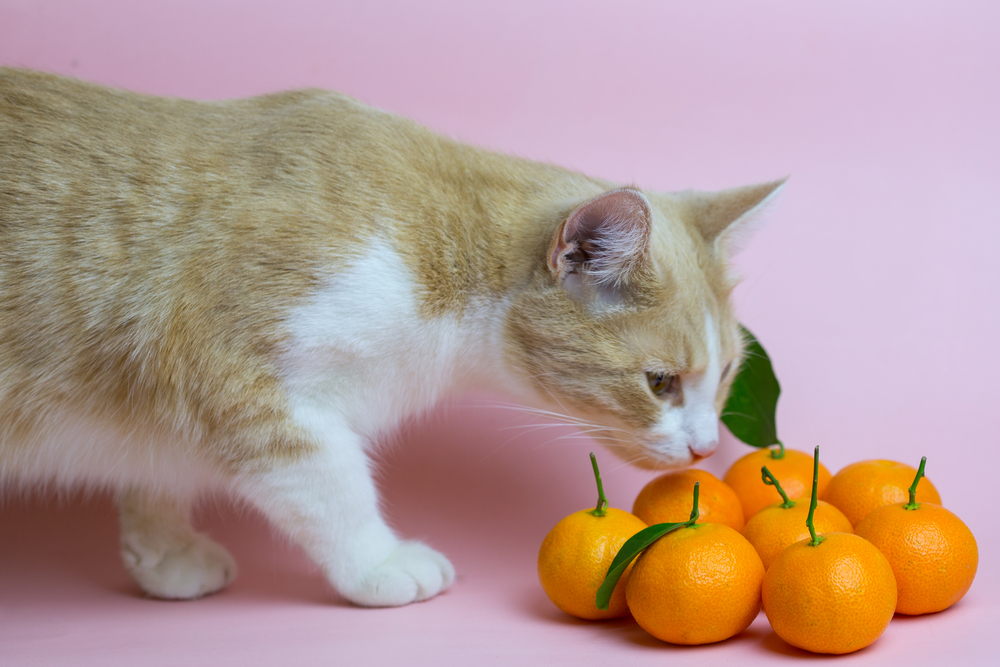
Cats can eat citrus fruits, but they need to be careful not to eat the seeds or the peel. Examples of citrus fruits include oranges, grapefruits, lemons, and limes are all citrus fruits.
All citrus fruits are excellent sources of vitamin C. In fact, oranges have more vitamin C than lemons and limes.
Possible risks of feeding apricot to your cat
The seeds can be a choking hazard, and the peel can cause digestive upset.
19. Nectarine
Cats can eat nectarines, but they should only eat a small amount. The fruit is very similar to the peach, but it has smooth skin. Nectarines are available in many colors including white, yellow, pink, and red.
Possible risks of feeding nectarine to your cat
Nectarines are safe for cats to eat, but as with any food, you should introduce them slowly to avoid any stomach upsets.
When eaten in large quantities, nectarines can make your cat experience stomach upsets. If your cat does have an upset stomach after eating nectarines, contact your veterinarian immediately.

20. Papaya
Papayas are safe for cats to eat in moderation. They are an excellent source of vitamins A and C, as well as fiber. Vitamin C is a powerful antioxidant that can help to protect cells from damage, and it is also essential for wound healing.
However, they should not be a cat’s only source of nutrition, as they do not contain all of the nutrients that cats need. Cats who eat papaya may experience some digestive upset, so it is best to introduce it into their diet slowly.
Possible risks of feeding papaya to your cat
Papayas should be ripe before they are fed to cats. Unripe papayas can cause stomach upset in cats. Additionally, papayas should also be seeded before they are fed to cats, as the seeds can cause intestinal blockages.
21. Pear
Cats can eat pears but in small quantities. Pears are an excellent source of dietary fiber, vitamins C and K, and copper. They also contain smaller amounts of other nutrients, including vitamin E, B vitamins, potassium, and magnesium.
Possible risks of feeding pear to your cat
Pears may contain harmful toxins that can cause vomiting and diarrhea in cats. Because of this, the fruit should only be given to cats in small amounts as a treat.

22. Plum
Cats can eat plums, which are a good source of vitamins A and C. It also contains fiber, potassium, and other minerals.
Eating plum can help improve your cat’s overall health. The fruit’s vitamins and minerals can help boost their immune system, while the fiber can aid in digestion.
Possible risks of feeding plum to your cat:
As with any new food, introduce plum to your cat slowly to avoid stomach upset. Also, make sure the fruit is pitted before feeding it to your feline friend.
Additionally, only feed your cat plums in moderation as ASPCA lists them as toxic when ingested in large amounts.
23. Pomegranate
Cats can safely eat pomegranates but they should do it in moderation. The fruit packs a lot of antioxidants that can boost a feline’s health.
Possible risks of feeding pomegranate to your cat:
Cats should stay away from pomegranate seeds as they pose a choking hazard. Feeding a lot of the fruit will also most likely harm your furry friend’s stomach, so keep it in moderation.
Pomegranates also have a lot of sugar which could lead to obesity in cats.
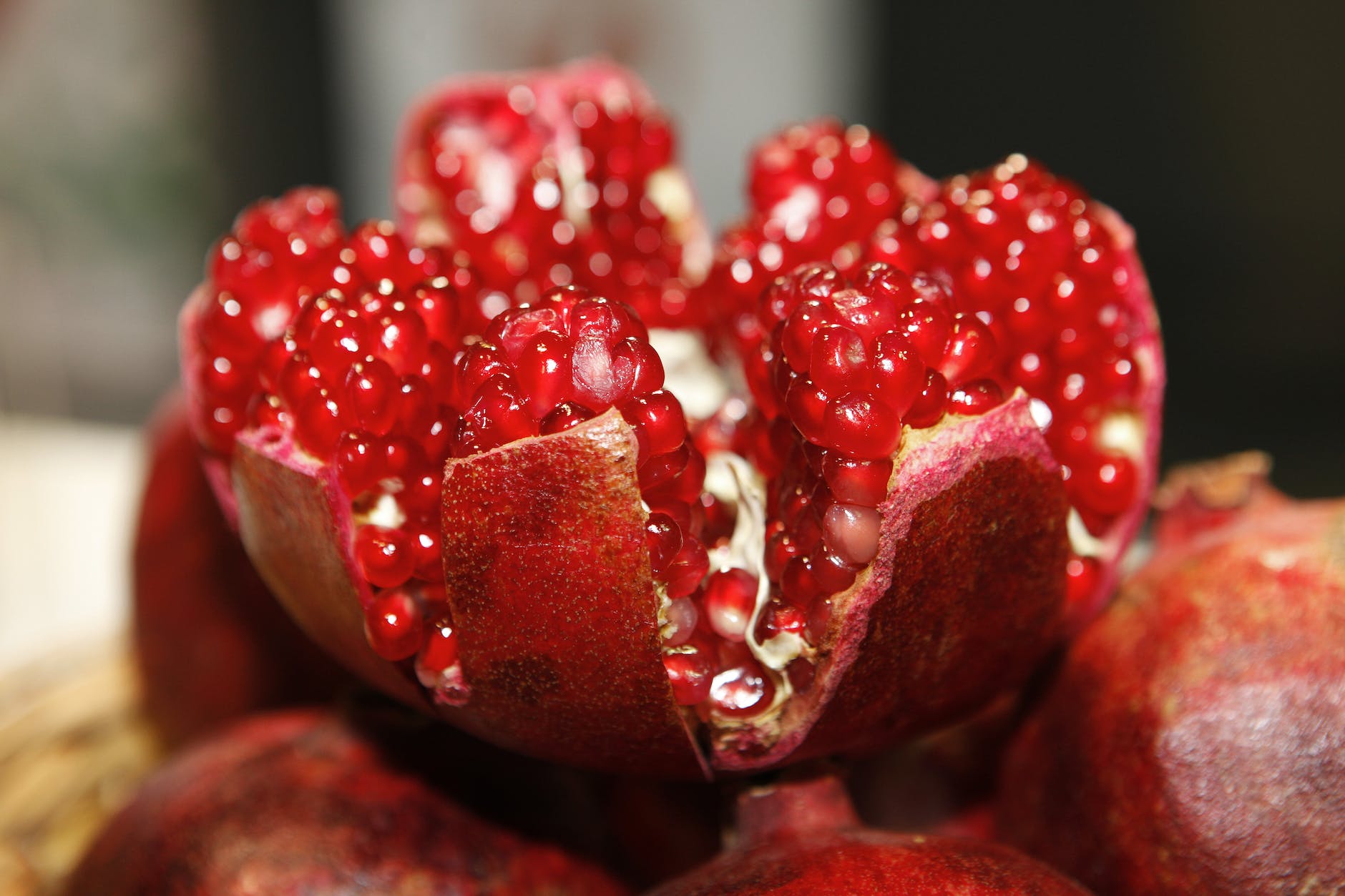
24. Kiwi
Cats can safely eat kiwi fruits and it would be a great addition to their diet. The high vitamin C content in kiwis can help boost the immune system, while the antioxidants may help protect against some types of cancer.
The fiber in this hairy fruit can also help promote your furry bestie’s digestive health.
Possible risks of feeding kiwi to your cat:
While kiwis are generally safe for cats to eat, there is a small risk of choking or gastrointestinal blockage if the fruit is not properly chewed
In addition, the seeds of the fruit contain cyanide which can be poisonous if ingested in large quantities. Therefore, it is important to remove the seeds before feeding kiwis to your cat.
Wondering which veggie is safe for your cat? Here are 12 vegetables your cat can safely eat.
25. Olives
Olives are safe for cats to eat as it is listed as a non-toxic fruit to cats by ASPCA. The fruit is packed with lots of antioxidants including calcium, iron, copper, and vitamin E.
Possible risks of feeding olives to your cat:
Olives are acidic fruits and can make your cat have a stomach ache. Additionally, pickled olives contain too much for your cat and may lead to poisoning.
Finally, the pits in olives also pose a choking hazard. Be sure to remove it before you feed your cat.
What are the benefits of feeding fruits to cats?
Feeding cats fruits can improve their overall health
Cats fed a diet of fruits and vegetables show increased levels of vitamins A, C, and E in their blood. They also have improved digestion and gut health, as well as better skin and coat condition.
Feeding cats fruits can help them maintain a healthy weight
Feeding cats fruits can help them maintain a healthy weight. Fruits are low in calories and fat, so they are a great option for cats who need to lose weight. Aim to stick to fruits that are low in sugar.
You should also avoid giving your cat citrus fruits like oranges and lemons, as well as grapes and raisins, which can be toxic to cats.
If your cat has not been eating the right food, try adding fruits to their diet. Fruits can be added to wet and dry cat food in small amounts.
Feeding cats fruits can help them stay hydrated
Cats need to stay hydrated, and one way to do that is to feed them fruits. Fruits that are good for cats include watermelon, cantaloupe, honeydew, and oranges. These fruits are high in water content and can help keep your cat hydrated.

Feeding cats fruits can provide them with essential nutrients
Fruits are a great source of nutrients for cats. They are packed with vitamins, minerals, and antioxidants that can help keep your cat healthy.
For instance, these nutrients help boost their immune system, improve their digestion, and give them a healthy coat and skin.
Feeding cats fruits can help them avoid gastrointestinal issues
Some fruits like are full of dietary fiber that can help your kitty with passing poop more comfortably.
What are the risks of feeding fruits to cats?
Risks of feeding fruits to cats
Fruit can cause stomach upset in cats.
Cats lack the ability to properly digest fruit, and feeding it to them can cause stomach upset. Symptoms of stomach upset in cats include vomiting, diarrhea, and loss of appetite.
If you notice your cat exhibiting any of these symptoms after eating fruit, it’s best to stop feeding it to them and consult your veterinarian.
Fruit can contain harmful toxins.
Certain fruits contain harmful toxins that can be dangerous for cats. For example, grapes and raisins contain a toxin that can cause kidney damage in cats. So, it’s important to avoid feeding these fruits to your cat altogether.
Cats can choke on fruit.
Feeding your cat whole fruits is dangerous and can lead to choking. Fruits with pits like apples also pose a choking hazard.

Risks of feeding fruits to cats with diabetes
All fruits contain sugar, which can be a problem for cats with diabetes. The sugar in fruit can cause spikes in blood sugar levels, which can be dangerous for diabetic cats.
If you do choose to feed fruit to your diabetic cat, it is important to monitor their blood sugar levels closely and speak to your veterinarian about the best way to do so.
Risks of feeding fruits to cats with kidney disease
There are some fruits that are safe for cats with kidney disease to eat. Consider feeding your cat with a kidney problem only food that is low in phosphorus.
These include blueberries, apples, and watermelons. These fruits are high in antioxidants and can help to protect the kidneys from damage.
Fruits that are risky:
There are some fruits that are riskier for cats with kidney disease to eat. These include grapes, raisins, and currants. These fruits contain high levels of potassium and can worsen kidney function.
If you decide to feed your cat fruit, it is important to monitor their intake closely. Too much fruit can cause gastrointestinal upset and diarrhea.
If you notice any changes in your cat’s health or behavior after eating fruit, stop feeding it to them immediately and consult your veterinarian.
Risks of feeding fruits to pregnant cats
As with humans, pregnant cats are delicate and as a pet owner, you need to watch what they eat. Some fruits may contain toxins and pesticides that may harm the developing kittens.
Considering how sensitive their stomach is, pregnant cats may develop stomach issues from simply eating fruit. This can happen even though they previously enjoyed munching on some bananas.
Additionally, fruits increase the risk for cats to develop diabetes later in life due to the high sugar levels that may spike blood sugar levels.
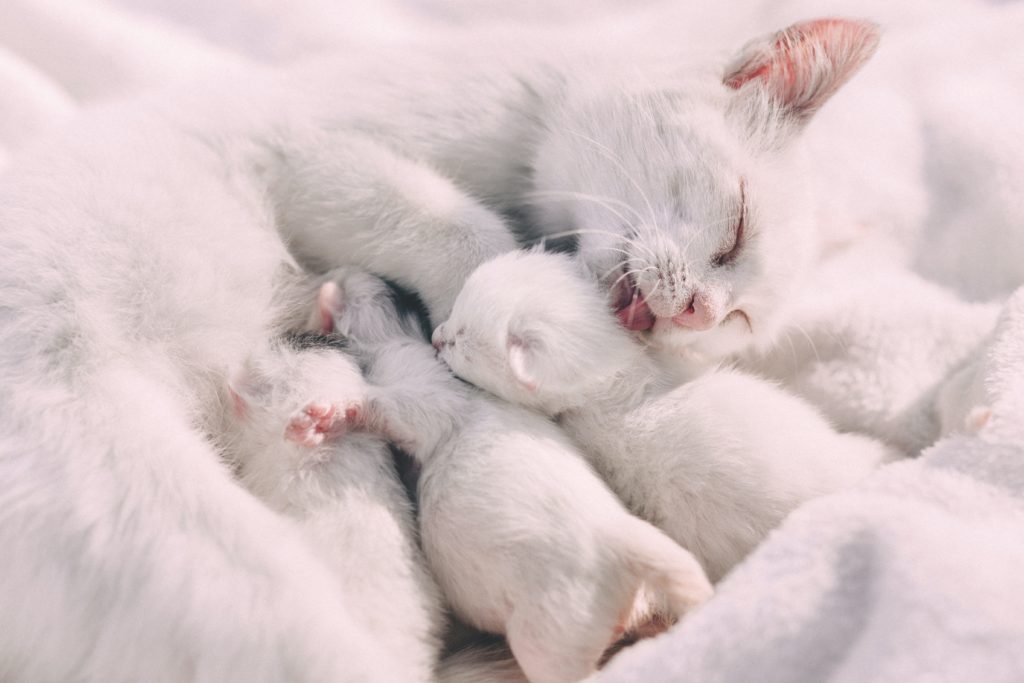
Risks of feeding fruits to kittens
Feeding fruits to kittens can be risky, as some fruits contain toxins that can be harmful to them. Additionally, if a kitten ingests too much fruit, they may develop diarrhea or other gastrointestinal issues.
To prevent your kitten from being harmed by toxins in fruit, only feed them small amounts of fresh fruit that has been washed thoroughly.
Avoid feeding them dried fruit or fruit that has been sitting out for a long time, as these may contain higher levels of toxins.
If you are unsure about whether or not a particular fruit is safe for your kitten to eat, consult with your veterinarian beforehand.
How can I introduce fruits into my cat’s diet?
The American Society for the Prevention of Cruelty to Animals (ASPCA) suggests that you start by feeding your cat a small amount of fruit, about the size of a green pea. If they enjoy it and have no digestive issues, you can gradually increase the amount.
While fruits are not a necessary part of a cat’s diet, they can be a healthy and delicious treat. The key is to choose the right fruits and introduce them slowly so that your cat’s digestive system can adjust.
What are some creative ways to feed fruits to my cat?
- Try different types of fruits to see which ones your cat enjoys the most.
- Offer a variety of fruits in small amounts throughout the day as part of a healthy diet.
- Make sure to wash all fruits thoroughly before feeding them to your cat.
Safety tips for feeding your cat fruit
1. Introduce new foods slowly.
When you’re introducing your cat to new foods, it’s important to do so slowly. This will help them get used to the new flavors and textures, and it will also help you figure out if they have any allergies.
Start by mixing a small amount of the new food in with their regular food. If they seem to like it, you can gradually increase the amount of new food until they’re eating mostly the new stuff.
2. Cut the food into bite-sized pieces.
When feeding your cat fruit and vegetables, it’s important to cut the food into bite-sized pieces. This will help your cat to chew and digest the food more easily.
3. Monitor your cat for a negative reaction.
If your cat starts to show any of the following signs after eating fruit or vegetables, it’s best to stop feeding them and consult with your veterinarian:
- Diarrhea
- Vomiting
- Abdominal pain or bloating
- Loss of appetite
- lethargy
4. Avoid feeding your cat peels, seeds, and pits.
Your cat could choke on peels, seeds, or pits. These items can also cause digestive problems if swallowed.
If your cat swallows any of these items, call your veterinarian immediately. They will likely need to be seen by a professional and may require surgery to remove the item from their digestive tract.
5. Keep fruits and vegetables a minor part of your cat’s diet.
While fruit is generally healthy for cats, feeding them too much can cause digestive problems. Stick to giving them small pieces of fruit as a treat, rather than making it a large part of their diet.
Make sure to wash them thoroughly first, as some may contain harmful pesticides or other chemicals.
How many fruits to include in your cat’s diet?
Fruits should only make up a small part of your cat’s diet – no more than 10% according to most vets. Keep in mind that cats are obligate carnivores and need meat to survive.
And if you’re unsure about whether a particular fruit is safe for your cat to eat, it’s always best to consult with your veterinarian first.
What are some common fruits that are poisonous to cats?
- Almonds
- Dates
- Macadamia nuts
- Raisins
How can I tell if my cat is allergic to a certain fruit?
If your cat is allergic to a certain fruit, they may experience symptoms such as itching, redness, swelling, or difficulty breathing. If you notice any of these signs, it’s important to take your cat to the vet right away.
Which other human foods are safe for cats?
There are a few other human foods that are safe for cats to eat. These include cooked eggs and chicken (without the bones), cottage cheese, and plain yogurt. You can also give your cat a small amount of peanut butter as a treat.
FAQ
Can cats eat fruit snacks?
Cats should not eat fruit snacks due to their high sugar content. It is best to stick with natural foods as the additives can be harmful to your furry friend.
